
.
Director: Cecil B. DeMille
By Roderick Heath
Cecil B. DeMille’s films are synonymous with a specific kind of cinema, a realm of grandiose subjects realised with an even more grandiose style. DeMille had trouble attuning himself to audience tastes in the early sound era with present-day stories like Dynamite (1929), Madame Satan (1930), and Four Frightened People (1934), whilst his splashy, Roman-age martyr romance Sign of the Cross (1932) was a hit. Hollywood in the Depression-defined 1930s was trending towards more present-tense, down-to-earth subjects and economical productions, compared to the inflated fancies of the late silent era. DeMille had exemplified that era as he became reputed for acts of elephantine showmanship like The Ten Commandments (1923) and King of Kings (1926), but his essential stock-in-trade was still the sexy but moralistic melodrama. Seeing an audience still hungry for larger-than-life thrills even in an officially more sober and straitened age, DeMille decided to redefine himself more properly as a maker of historical adventures, romances, and religious dramas, for which he’s remembered largely today beyond his place as one of the key progenitors of Hollywood’s first half-century. The Story of Dr. Wassell is something of an aberration in DeMille’s later career, as probably the most obscure film he made in that phase. Along with The Greatest Show on Earth (1952), it’s his only return to a present-day topic, and even his later Oscar-winner is only nominally contemporary, whereas The Story of Dr. Wassell engaged then-current geopolitics as DeMille’s lone contribution to the era of morale-boosting dramas made about and during World War II.
.

.
DeMille and two of his most regular screenwriting collaborators, Alan Le May and Charles Bennett, took on the life and adventures of Dr. Corydon M. Wassell, whose efforts during the evacuation of Java in the first weeks of the war with Japan earned him special praise from Franklin Roosevelt. Needless to say, DeMille may have been taking on hot-off-the-wires news but his approach was hardly the stuff of stony authenticity. He adapted Lost Horizon and Goodbye Mr Chips author James Hilton’s book about Wassell. The doctor was a man pushing sixty at the time of his exploits, whereas DeMille cast Gary Cooper as a romantic hero cast in mould both Hilton and DeMille were both fond of in their highly diverse ways – a searcher seeking new spiritual and humanistic horizons. DeMille kicks off in a manner swiftly becoming customary for him since he had first dared put his own voice on the soundtrack of North West Mounted Police (1940), with his spoken prologue paying tribute to a noble tradition. Or, in this case, two noble traditions. First he offers a hymn to the humble country doctor, the hardy creed to which Wassell belonged until he was drawn overseas to work in China’s missions, illustrated with a small bronze statue of a doctor in his horse-drawn buggy set before abstracted backdrops and assailed by snowflakes. DeMille had dealt with the war in sidelong fashion prior to this, trying to foster better relations between the USA and the British Empire on North West Mounted Police, and commenting on the then-raging Battle of the Atlantic through the historical likeness of wrecking and piracy in Reap the Wild Wind (1942).
.
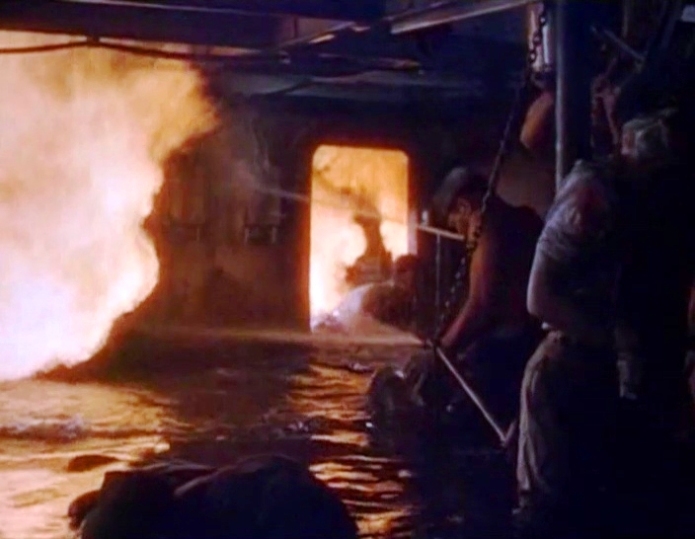
.
DeMille’s glossy, entertainment-at-all-costs template might have seemed out of place in context of the all too real, all too palpable war, which was giving birth to a new mode of cinema embracing a blend of traditional filmmaking and documentary techniques, resulting in the birth of neorealism in Italy and variations in Britain and France, and even starting to influence Hollywood. And yet what better filmmaker than the man used to evoking the wraths of gods and rise and fall of nations to portray something close to an apocalyptic moment for so much of the world? The onset of war for America saw moviemakers rush to deal with the bruising and deadly events of the Pacific war’s first few months, for the most part a period of unstinting calamity for the US and other Allies. Rather than tiptoe around such ignominy, Hollywood’s newborn propagandists saw the value in downbeat tales like Wake Island (1942) and Bataan (1943), casting them as neo-Alamos to inspire the next wave of warriors. The Story of Dr. Wassell stands aloof from such movies in a surprising way, sporting very little actual, military action and instead concentrating on non-combatants attempting to escape the eye of an oncoming storm. Even a climactic assault by the Japanese on a last Dutch redoubt in Java is depicted chiefly via a radio broadcast.
.

.
The story proper starts in the immediate wake of Pearl Harbor and the Japanese advance into South East Asia. DeMille’s voiceover next celebrates the fame of the USS Marblehead, a cruiser severely damaged during the Battle of the Makassar Strait. The battered, burning ship is seen on screen, her innards a trap of flooding water and boiling fire and limping her way into a port on Java in Indonesia, or the Dutch East Indies as it was called at the time. One of DeMille’s trademark panoramic introduction scenes follows, one that sees multiple characters meeting and interacting in the midst of a staging area for great events. Badly injured men are unloaded under Wassell’s supervision, as he’s now a navy surgeon commanding a hospital train sent to fetch the wounded and take them to a hospital. Wassell here meets the men from the Marblehead whose future will soon be bound up fatefully with his own, and also encounters two old friends from his missionary days: mission nurse Madeleine (Laraine Day), and his former research assistant Ping (Philip Ahn). All have been flung together in the desperate migration pushed ahead of the Japanese advance.
.

.
Wassell and his team of steadfast nurses patch up the injured with the aid of a terse Chinese doctor (Richard Loo) on the train, and the wounded are installed in a hospital in central Java. But after the Japanese capture Singapore and invade Java, the hospital is bombed, killing Ping. Wassell is ordered to only evacuate walking wounded on transport ships, and leave behind the worst cases to be captured. Wassell decides to ignore the order and try to send stretcher cases out to a transport ship with the other wounded, but they’re spotted in the process by an officer who chides Wassell but also agrees to his request to have his orders amended to stay with the men left behind. After travelling back to their hospital to find it in ruins, Wassell encounters a convoy of British soldiers retreating before the Japanese, planning to reach another port and meet up with more transport ships, and the British CO (Richard Aherne) readily agrees to ferry Wassell and his charges along with them. But this proves to be merely the start of an arduous odyssey as it seems like all of heaven and earth are conspiring to destroy Wassell’s ragged band.
.

.
To appreciate the best aspects of The Story of Dr. Wassell, as with many DeMille films, is to wade through some pure cornball and ungainly, runtime-hogging comedy that feels better suited to a serviceman comedy or a lesser MASH episode than a tale of such catastrophic urgency, before the film gets on a roll. So lumpy is The Story of Dr. Wassell because of some of this that some have called it DeMille’s worst movie. But I find it better than that, and once the film does really get moving, the second half proves a lesson from a master in big, vivid, suspenseful staging. Most of the levity comes from Johnny Leeweather (Renny McEvoy), a walking wounded case from New York so obsessed with romancing he fills out his hospital bunk with an improvised dummy and finally misses his chance to leave because he’s been too busy canoodling with the Javanese ladies. The director, who always knew how to sex up even the most unlikely material, shoehorns in one of his patented dancing girl scenes, in this case half-European, half-Javanese nurse Tremartini (Carol Thurston), who invents a blend of jazz-baby hoochie-coochie and folk dance that sets the hot-blooded patients amok during an improvised festivity. Some of DeMille’s worst dramatic tendencies are enabled by the film’s attempts to bolster wartime alliance-building, as he has Wassell say, “There’ll be a special place in heaven for the Dutch,” before depicting a heroic Dutch soldier dying in a hail of bullets muttering, “God save the Queen!” in the kind of cornball vignette satirists have made a meal of ever since. DeMille once quipped that critics’ appreciation of the audience’s intelligence sank every time he released a movie.
.

.
Yet DeMille’s style was wrought in a fashion designed to be readily, easily accessible by a mass audience, and put across this openness with his open, pictographic visual style that betrays levels of intricacy in the way his camera shifts from vignette to vignette, knitting all together in a format that can only be likened to a mobile fresco. DeMille’s fondness for framings as carefully composed and lit as neoclassical paintings is much in evidence, although sacrificed to a more imperative pace of cutting than he usually wielded. His method of trying to please a panorama of tastes in that audience with flourishes from multiple genres was undoubtedly part of his success, but today you have to go to the Chinese and Indian film industries to see the same approach, especially compared to the increasingly monomaniacal stylistic approach to contemporary Hollywood franchise cinema. DeMille’s feat as a director who could speak to such a vast audience still doesn’t gain much appreciation, and yet which fascinates me deeply, an argot as stylised as anything in cinema and yet not perceived as such. Moreover, once it gets going, The Story of Dr. Wassell, along with his next film and one that has a claim to being his best, Unconquered (1947), belongs to a brief phase of relative toughness and grittiness for the director, before he’d turn back to a more self-consciously artificial, totally stylised approach for Samson and Delilah (1949) and The Ten Commandments (1956), with The Greatest Show on Earth in between as a commentary on his own belief in moviemaking as salving act of communion between artists and audience.
.
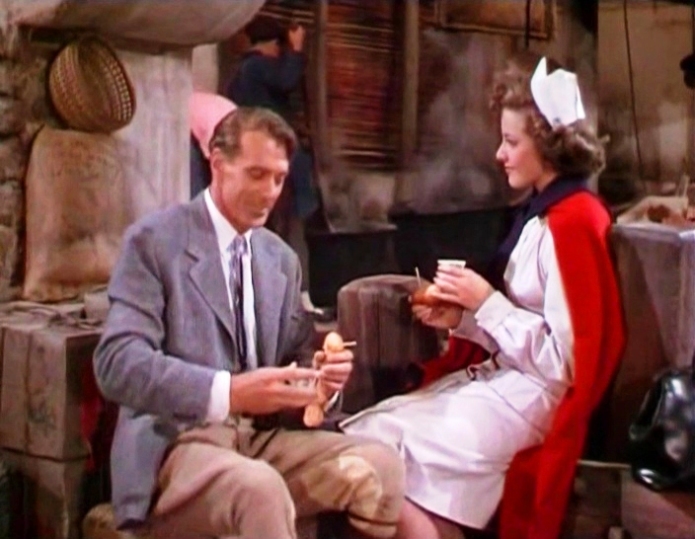
.
The Story of Dr. Wassell is also interestingly complicated by DeMille’s adoption of a flashback structure possibly influenced by In Which We Serve (1942), exploring defining episodes in Wassell’s life amidst the onward rush of the main drama. Ping begins to explain to the sailors Wassell’s past in the midst of a bombing raid after one of the wounded, the grumbling Murdock (Paul Kelly), rants fearfully about hearing a rumour Wassell fled China rather than face the Japanese there. Ping tries to correct this rumour by explaining how Wassell left his home in Arkansas after getting one too many pigs as payment from his poor rural patients, and falling in love with Madeleine’s picture, used as the image of the exemplary missionary worker in a flyer Wassell got in the mail. Wassell himself takes up narrating his experiences after Ping is killed, recounting his dedication to discovering a microbe causing virulent and deadly fevers in the Chinese interior which he believed to be carried by a species of rare snail. He formed a close bond with Madeleine as they worked with Ping, and was thrown into both professional and romantic rivalry with Dr Ralph Wayne (Lester Matthews). Wassell was split from Madeleine after being assigned to a remote station with Ping, but there he was able to isolate the microbe. Believing himself a success at last, Wassell intended to ask Madeleine to marry him, but then found Wayne beat him to the discovery. In defeat, Wassell instead encouraged her to take up Wayne’s marriage offer instead, before leaving the missionary service and joining the navy.
.

.
DeMille’s decision to tell his story in this fashion risked breaking up the pace of his drama, but it introduces a contrapuntal quality to the tale, the memory of labouring for years in dedication both altruistic and personal ambitions and the evanescent emotions of peacetime recalled in both its sublime and painful pettiness before the great trial arrives. For a director so often associated with adamantine moral values freely mixed with sensuous hype, DeMille had a telling penchant for badly flawed heroes. Often skilled as bringers of violence and accomplished in the hardier arts of life, DeMille’s protagonists are eventually obliged to writhe their way pathetically towards transcendence, heroes fit for a more rambunctious world trying desperately to become its better self. That description is true of figures like Fredric March’s love-struck tribune in The Sign of the Cross, Henry Wilcoxon’s Richard the Lionheart in The Crusades (1935), Cooper’s Wild Bill Hickok in The Plainsman (1936), and Victor Mature’s Samson. Wassell, by contrast, is established as a constantly frustrated protagonist whose nobility stems in large part precisely from his well-exercised gifts for self-effacement and coping with crushing twists of fate. As a character Wassell accords with Cooper’s preference for playing strong yet slightly offbeat, pensively modest characters, a natural succession from his Oscar-winning role as Alvin York as another man who manages to be heroic with sensibility that’s notably at odds with the age of mass slaughter. DeMille gives shading and dramatic tension to the portrait by having characters raise the spectre of Wassell’s past failures and rumours that he ran out on his responsibilities in China, charges Ping determinedly puts down.
.
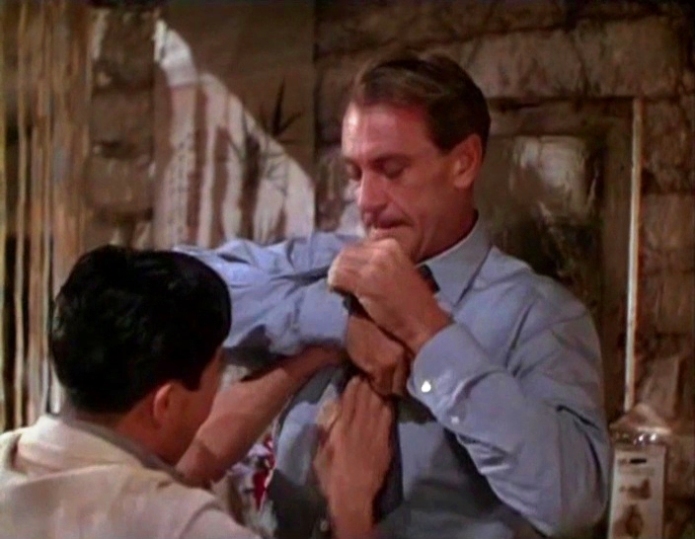
.
The film’s better comedy interludes come from Cooper, giving a quiet master class in playing physical awkwardness, including a brilliant little dance of actions with Ahn as Ping tries to help Wassell dress for a date with Madeleine, and near the end, when Wassell hears Roosevelt’s voice speak his name on the radio, arresting him as he starts to sit and making him holt upright to rigid attention again. Wassell embodies many qualities DeMille found worthy, particular the hero who’s a prisoner of honour, holding his tongue and refusing to make others beholden or to make excuses for himself. He’s also something of a rough draft for DeMille’s concept of Moses, a man who arrives at the level of maturity required to lead an exodus after trials of identity and moral and emotional reflex, encountering multiple references of culture and history. Most of the other characters around Wassell are open books, the sailors all avatars for a certain lively, clean-cut, scrappily life-hungry ideal of American youth, identified closely with home states and all the totemic meaning of nicknames and fond associations. Cmdr Bill Goggins (Stanley Ridges) is a strong and strict voice of leadership who is good friends with Wassell, but is frustrated by his injuries that keep him rigidly dressed and bedbound. Badly-burned Benjamin ‘Hoppy’ Hopkins (Dennis O’Keefe) becomes attached to the whimsically named Tremartini after she donates blood to him. Mangled romantic ‘Andy’ Anderson (Elliott Reid) quickly develops a crush on Dutch nurse Bettina (Signe Hasso).
.

.
Bettina already has an interested beau, gutsy Dutch soldier Lt Dirk Van Daal (Carl Esmond), and the stage seems set for one of DeMille’s familiar romantic triangles. Except that, recognising Andy’s crush, Dirk calmly tells the American that, given the utter chaos of their lives, neither has a right to claim Bettina, so they make a pact to both look after her until war’s end and then contest the issue. If Wassell is a contemporary Moses, Hoppy is a Samson who must face his own battle against an army single-handed, armed with Tommy gun rather than the jaw-bone of an ass. Tremartini is another familiar DeMille figuration, the simple and innocent girl who falls for a man, tethered to him on a perfect, sublime level but also doomed by the purity of that ardour: she feels they’re connected permanently after she’s given him her blood. The story of all these characters allowed DeMille an honourable way to engage with the war and portray the sorts of qualities he admired without celebrating bloodthirstiness, through a focal figure whose business is not feats of warfare but saving lives. The sailors for the most part can no longer fight, but get to display other forms of bravery and gallantry, as when they band together to distract a young boy from his mother’s death in machine gun fire hailing all about them.
.
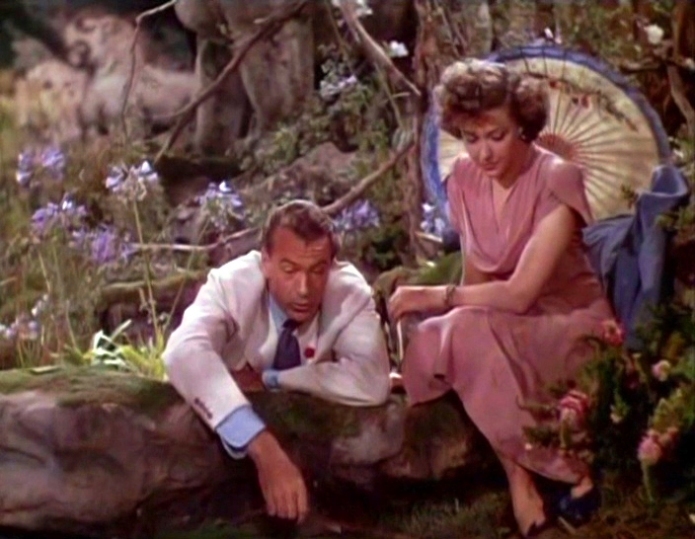
.
The pivotal sequence involves Wassell’s charges being denied their place on a ship home, hard military facts butting up against earnest humanitarian urges as Wasell makes a forlorn but hopeless appeal to a higher ranking officer to look the other way and give a break to men desperate for escape and deserving of it. Later it’s revealed that this tortuous moment actually saves the men’s lives, as the ship they were supposed to board was sunk. When Wassell learns this he thinks Madeleine, who was on that ship, died too. The Story of Dr. Wassell was DeMille’s third film in colour, with Victor Milner and William E. Snyder his cinematographers. It’s some measure of DeMille’s clout that he was able to make such a big-scale production in colour right in the middle of the war. But where colour was primarily a decorative device for DeMille on his first two efforts, here was the first occasion in which he evinced the overtly spiritual use of it he would exercise more completely in Samson and Delilah and The Ten Commandments, decorating corners of his tale of cosmic violence with promises of redemptive beauty. A flashback to Wassell and Madeleine seated by a pond in an old temple sees them amidst a riot of blooms of flowers, the multihued skins of exotic fish, crumbling statuary, and overgrown foliage.
.
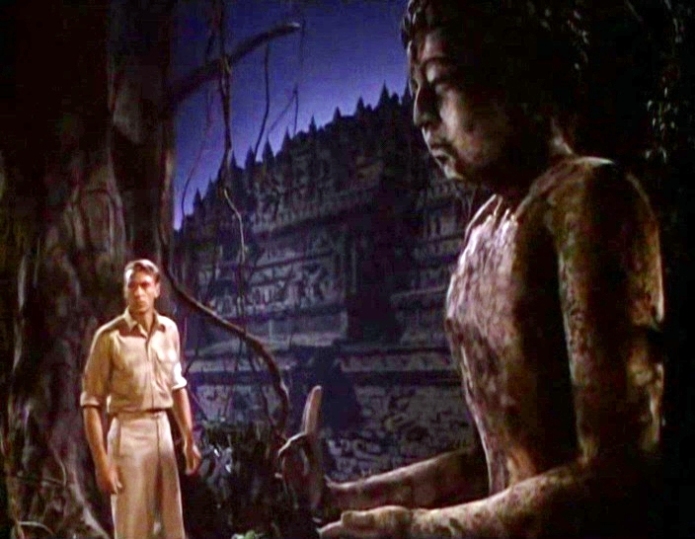
.
This sequence is rhymed by a later, nocturnal scene where Wassell, poised on the edge of fatalistic despair, leaves the hospital and makes his way through the night to investigate the sound of moving traffic. He encounters a statue of Buddha outside another such ruined temple, a grand, vine, tangled form in the background under pale moonlight, the statue looming with silent, boding promise. Wassell finds himself making desperate appeal to Buddha, and is met immediately by a seeming miracle as he recognises the singing coming from the passing convoy of trucks as that of British soldiers. It’s hard to imagine film artists more different to DeMille, than Sam Fuller and Francis Coppola (on some levels at least: none of them was averse to big thinking and broad statements), and yet this scene opens a door to both Fuller’s China Gate (1957) and Coppola’s Apocalypse Now (1979), both of which similarly depict the psychic shock of rock-ribbed faiths of western certainty gazing in trepidation at the stark, carved imagery of the east’s mirroring faiths and opaque history, in the context of wars that send different creeds, nations, and ways of understanding into violent collision. The chief difference is that DeMille’s vision is determinedly positive, embracing the possibility of faith taking on manifold faces. This idea recalls the cumulative message of The Crusades where Richard and Saladin made peace on the back of mutual love Berengaria’s question as to what it really mattered what path one took to find enlightenment.
.
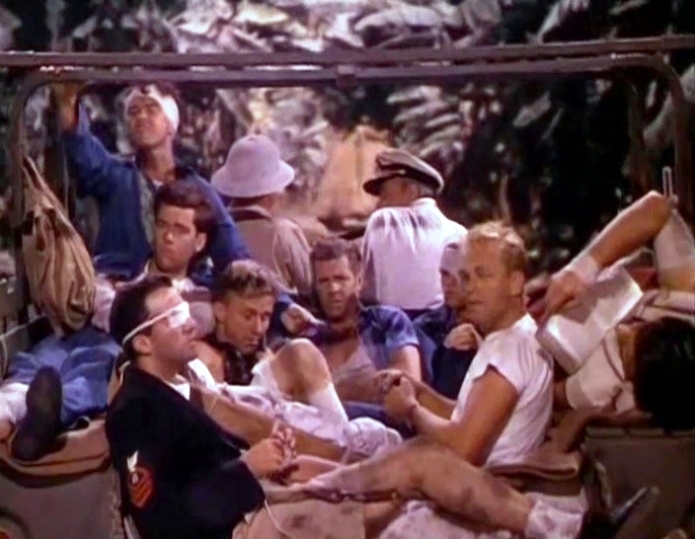
.
Although DeMille’s faiths secular and spiritual are eventually affirmed throughout the film, nonetheless he’s also obliged to depict a dreadful moment in history, the forces of western influence in Asia being chased out by a ruthless broom. One quality of DeMille’s efforts that still distinguishes them effectively from so many films labelled as epic was precisely his assurance that such grandiose themes could only be articulated through dramas staged on the largest possible scale. For DeMille, questions of religious conscience or humanitarian obligation weren’t ideas to be explored on the level of Ingmar Bergman’s tortured neurotics but in direct engagement with grand narratives. DeMille’s vision grew increasingly familiar with the apocalyptic, first evinced here in the midst of wartime and growing more urgent as the immense popularity of his biblical epics seemed rooted in their ability to comprehend the atomic age’s landscape in trepidation. But DeMille’s most revealing choice here is to leave the enemy almost entirely unseen, except for a brief, vague glimpse of a soldier crawling through underbrush. The wartime foe is rendered an abstract power of wrath and destruction, anticipating the formless force of annihilation that arrives in the Pesach sequence of The Ten Commandments. Bombs fall and shake the earth, smashing homes and sanctuaries and great works, a divine wrath tormenting his mere humans but also driving them towards new states of being.
.

.
The central set-piece sequence sees the British convoy trying to run across a huge bridge under heavy enemy shelling. A truck blows up in front of the lorry Wassell drives, forcing him onto a wild, careening ride off the road and through the yards of hapless villager as his load of injured men are tossed about. Hoppy and Tremartini, riding in a jeep behind, are blown off the road. Their vehicle tumbles to the foot of a steep embankment, their driver killed, and Hoppy is crippled with a broken leg. Wassell tries to return to get them, only to see the bridge crumble under the impact of a bomb, cutting him off. The mighty structure disintegrates with all the epic, terrible stature of the statue of Dagon in Samson and Delilah, another idol of human pretence laid flat. Tremartini refuses to leave Hoppy, so the duo make ready to fight off advancing Japanese soldiers with a Tommy gun: DeMille fades out as Hoppy releases his first, furious bursts in a battle that can only end one way, fading into the existential void of the screen dissolve. Even when Wassell and his charges finally manage to get aboard a passenger liner, the Janssen, crammed to the gunwales with refugees, with Wassell distracting her captain as the wounded men are sneaked aboard at the stern. Even then their ordeal isn’t over, as the ship has sneak out of harbour and elude Japanese patrols, saved by a fog that obscures their progress for a time but soon disperses and leaves the ship naked before attacking planes. DeMille was always a consummate technician, with a gift not simply for building big sets and staging good special effects, but for manipulating his actors and human elements in a way that made all that infrastructure almost animate.
.

.
The crash of Hoppy and Tremartini is a particularly clever bit of staging that manages a seamless illusion in the way DeMille has the actors secreted around the set, the jeep tumbling down the slope and slamming to a halt, O’Keefe sliding into view and Thurston seeming to emerge from the wreck. The bridge sequence and ship attack involve special effects and come on with tremendous force and precisely deployed detail, superlatively cut together by Anne Bauchens. DeMille had originally hoped to cast Alan Ladd as Hoppy, casting O’Keefe instead, normally an RKO contract player who appeared the previous year in the Val Lewton-produced The Leopard Man, whilst another Lewton player, Edith Barrett, is glimpsed briefly as the mother of the small boy, dying in a thunderous peal of bullets. The film’s supporting cast is replete with character actors and stars on their way up or down, with faces like Yvonne De Carlo (originally slated to play Tremartini), Louis Jean Heydt, Victor Borge, former silent movie Tarzan Elmo Lincoln, Milton Kibbee, George Macready, Miles Mander, and Doodles Weaver all tucked in there somewhere. It shows the degree to which a DeMille production was a sort of tide pool for an entire industry, much in the same way that the events he depicts operates the same way for a whole society. If the film lacks something that DeMille’s best work always has, it’s a potent central romance with a strong female character at the axis of the drama to galvanise the larger canvas with intimate emotions. Hoppy and Tremartini’s doomed love is too naïve for this, and Madeleine and Bettina remain essentially marginal figures.
.
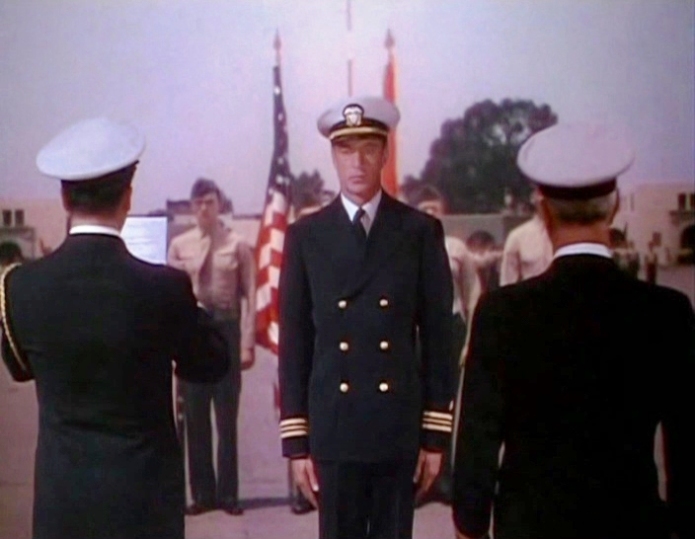
.
The personal drama likewise resolves cutely as Wassell encounters Dr Wayne on the Janssen and meets his wife (Catherine Craig), realising that Madeleine never did marry him; meanwhile Madeleine has been rescued from the wreckage of the sunken ship by a PBY, and hears Roosevelt talking about Wassell on the radio. DeMille nonetheless sustains the sense of running besiegement with all his practiced showmanship until almost the very end of the film. Wassell and colleagues keep on trying to save lives whilst everyone else is trying for one reason or another to end them, as attacking airplanes riddle the ship’s decks and sundry refugees with bullets. The tension between the wartime propagandist facet of the drama and the humane-pacifist streak is hardly resolved, but The Story of Dr. Wassell does add up to a tacit statement that the two can’t always be separated, that a fundamental irony of war is that it’s the scene of extraordinary struggle to save life as well as exterminate it. The final scenes, unfolding once the refugees have reached the safe harbour of Fremantle in Western Australia, see Wassell so used to getting the short end of the stick he expects to be court-martialled and punished for his loose approach to his orders, but he instead finds himself feted as a hero at last. It’s easy to imagine people living through the war laughing and sneering at the screen at this when it was released. But, of course, they still went to see it in droves, precisely because they knew they could rely on DeMille to process life into legend.
